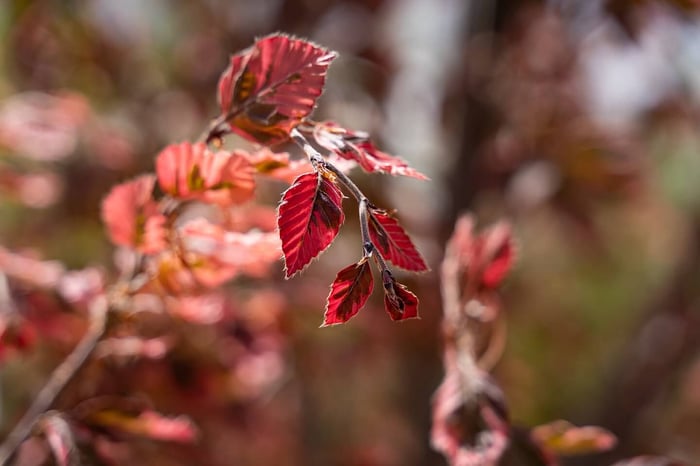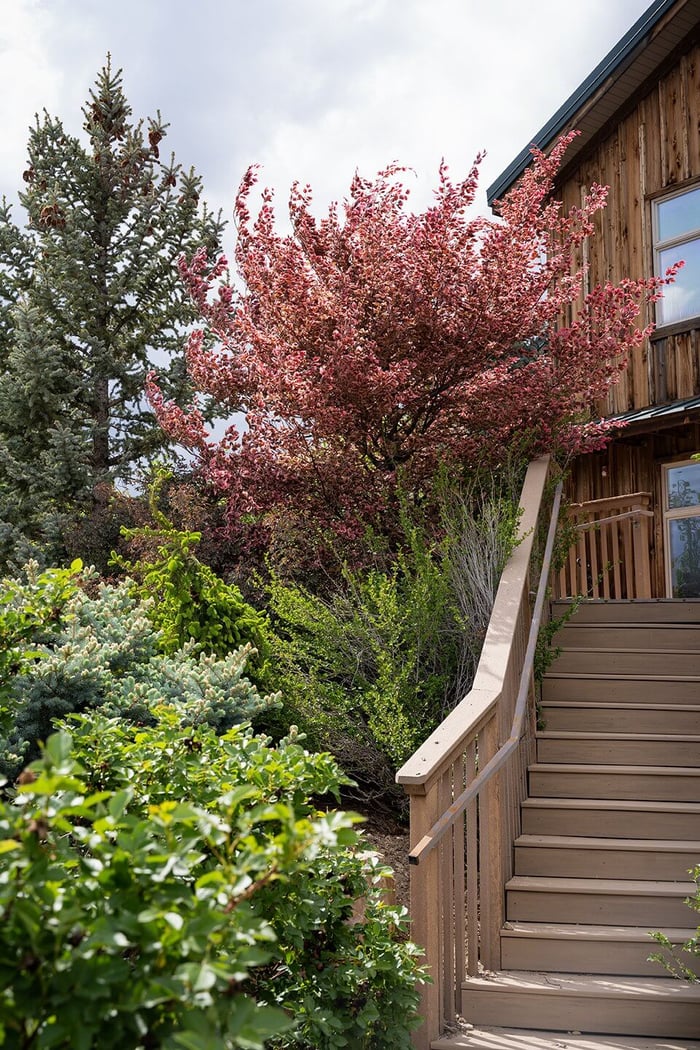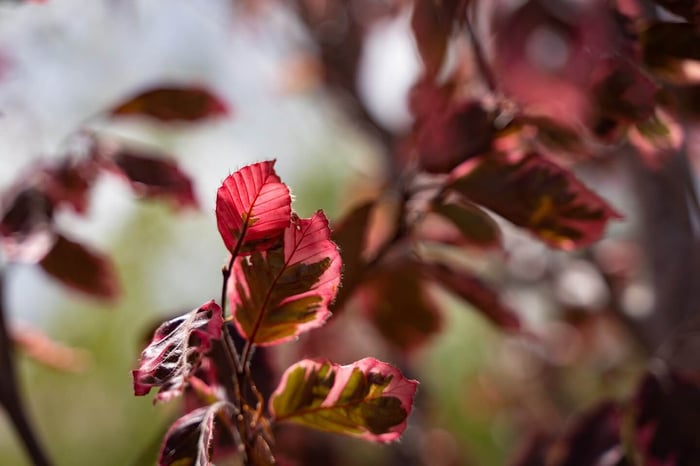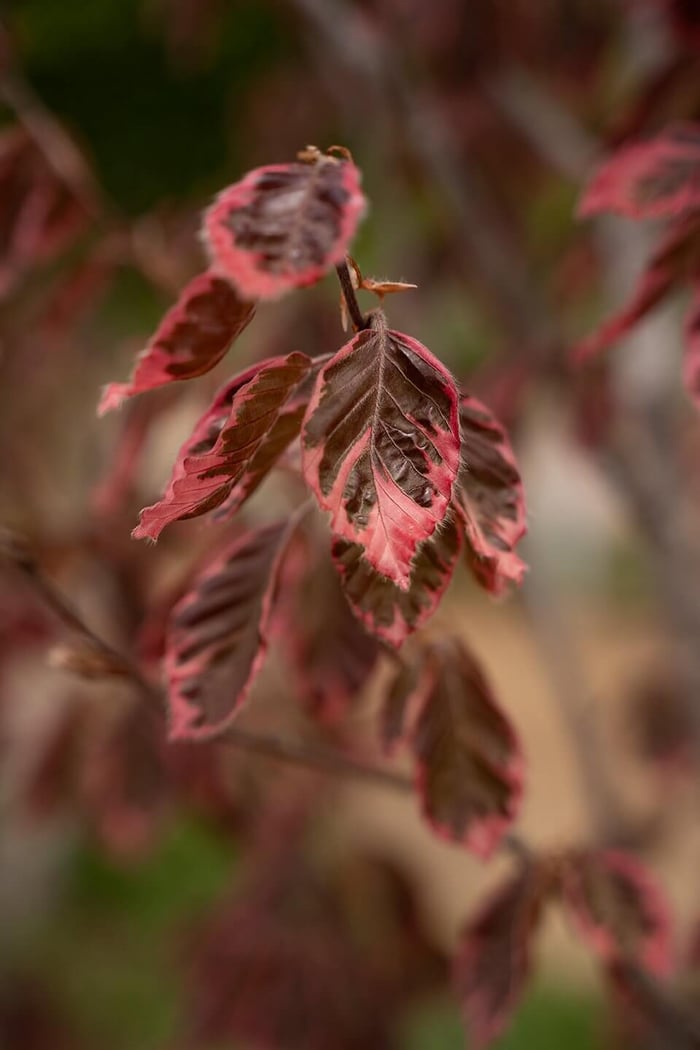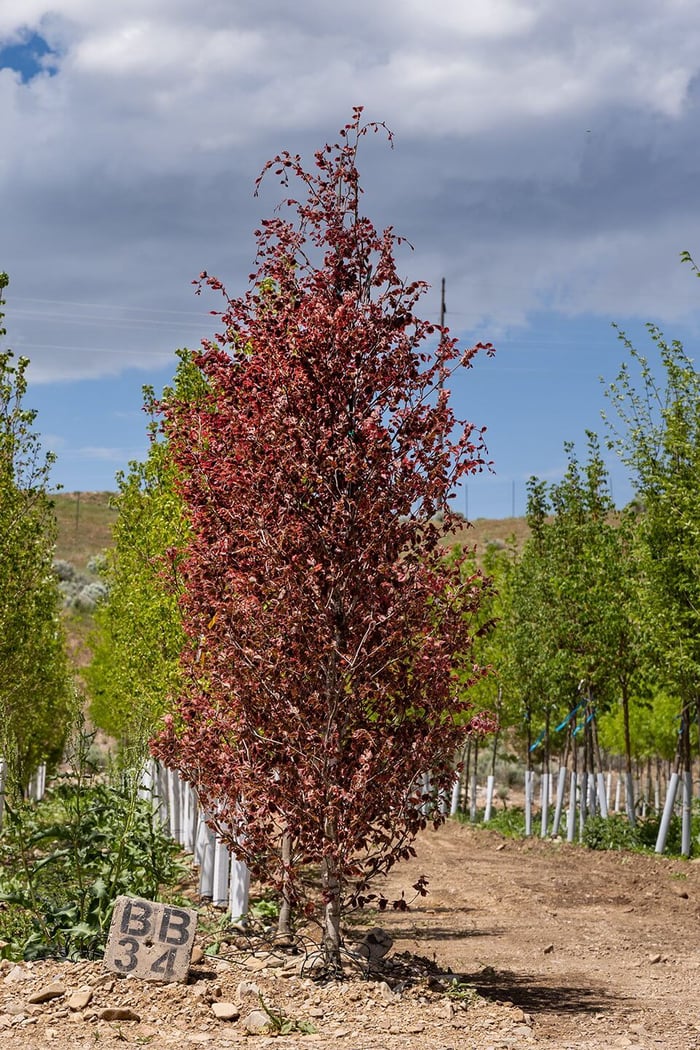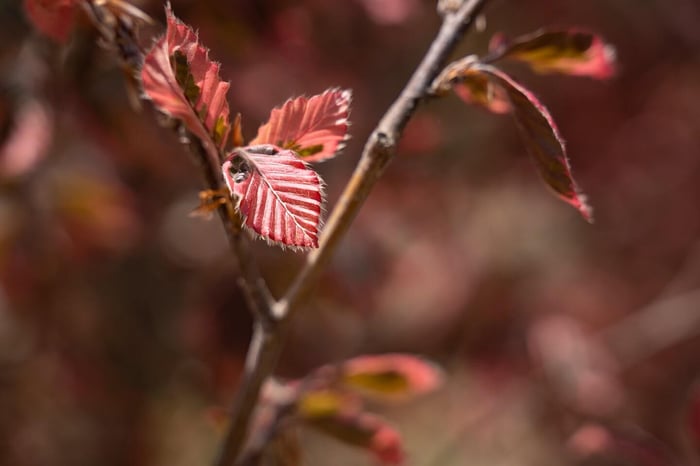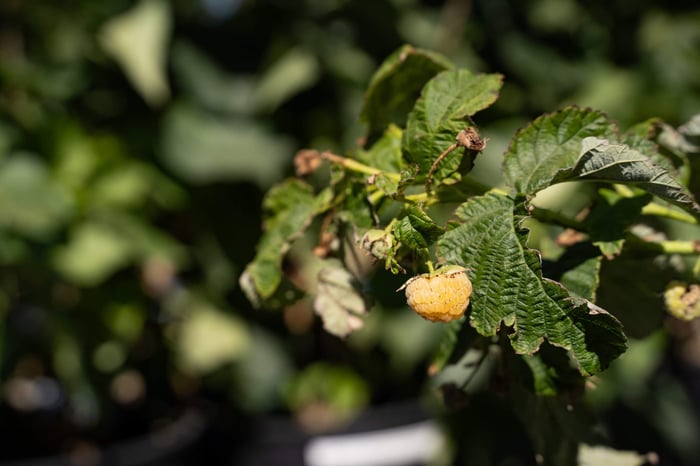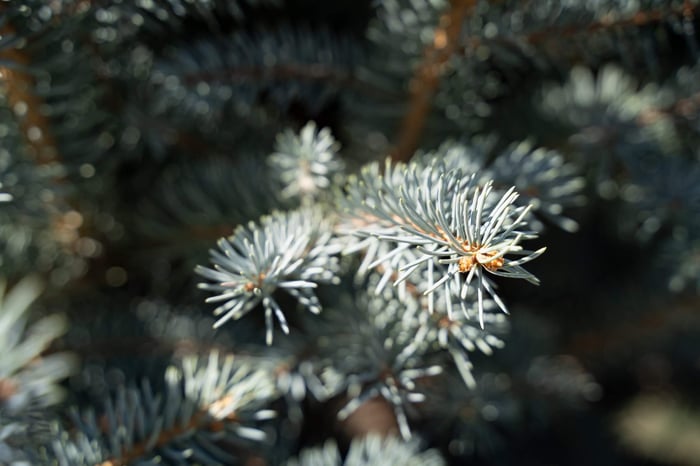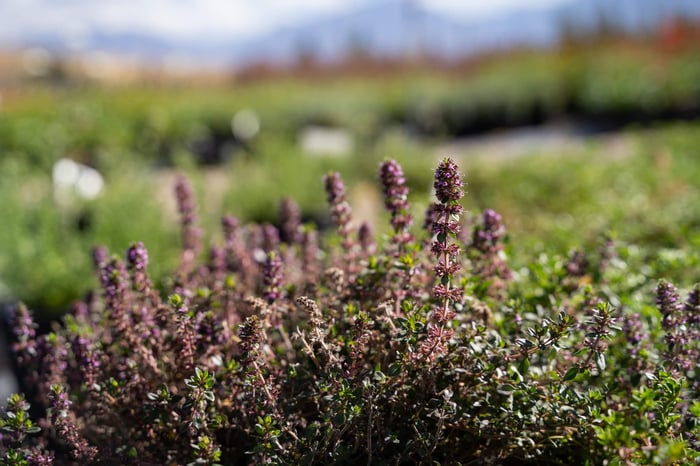Looking for a tree that offers year-round interest with silvery bark that stands out in winter and ever-changing foliage color throughout the growing season—something that’s both stately and dramatic? That’s a lot to expect from a single tree, but you’ll find all of that and more with a Tricolor Beech.
Ask anyone here at the nursery to list their favorite trees and beech will be somewhere on each person’s list. We love them for their strength and beauty, but there’s something about beech trees that captivates us, especially as they mature. They’re just solid. And stunning!
The Tricolor Beech, Fagus sylvatica 'Roseomarginata', is especially unique. It offers delicate pink and cream-edged new leaves in spring that mature to a soft, changing palette across the growing season—adding green, burgundy, and bronze as the season progresses. Plus, its growth habit creates a stunning, somewhat oval-shaped tree that is absolutely remarkable in the landscape. In the Intermountain West, where light, altitude and soil present unique challenges, this beech can become an ideal specimen—especially when it’s thoughtfully placed and cared for.
Why local gardeners love it
Tricolor Beech is excellent in Utah, Idaho, and Colorado for gardeners who want seasonal interest beyond flowers. Its variegated foliage provides contrast against evergreen backdrops and textured perennials. As a specimen or small screen tree it adds sophistication to courtyard gardens, foundation plantings and mixed borders. As you consider the microclimates in your yard and place it carefully, it will reward you with beauty and contrast.
Regional realities and how to work with them
Our region spans 4,000–8,000+ feet in elevation and brings its own set of challenges:
Our alkaline soils are often clay-heavy in the valleys and rocky or sandy in the mountains.
Hot, dry summers with intense UV light can lead to scalding leaves.
Cold winters with rapid temperature swings create freezing and thawing conditions.
Low humidity can cause desiccation.
A shorter growing season. Our final frost is typically late April to mid May, and the first frost can be as early as mid September to early October.
Frequent winds that dry the soil and leaves during summer and can desiccate plants during winter.
And limited water resources beg us to conserve.
Although Tricolor Beech prefers consistent moisture and well-drained, slightly acidic to neutral soils, we've found that they have been able to thrive here with just a little maintenance and planning, even in more alkaline soils. It helps if you do some prep work to create conditions that beech trees appreciate, rather than expecting the landscape to conform, but you will be surprised at how adaptable your beech actually is.
Practical planting and care—expert tips
Check hardiness for your site: Many beeches are cold-hardy but microclimates vary, so make sure the hardiness zone and elevation in your area is suitable before planting.
Place it in the right location: Choose a protected spot. Morning sun and afternoon shade is ideal in low-elevation valleys where summers are hot. At higher elevations you can allow more sun. Keep the tree sheltered from strong winter winds to reduce desiccation and bud damage.
Soil preparation: If your soil is alkaline, mulch heavily around your tree. Many people will recommend that you amend the planting hole with plenty of well-rotted compost and a small amount of acidifying organic matter such as leaf mold, pine fines, or well-aged composted bark to improve structure and provide a better root environment. However, your tree will send roots far beyond your planting hole. It will need to deal with our native soil soon enough. Sometimes, amending the soil in the hole essentially creates a clay pot that fills with water, leaving your tree roots to soak and rot in a soup of amended soil. Instead, consider planting on a slightly raised mound or in a raised bed and mulch heavily. Be sure not to plant your tree too deep or place mulch against the base of the tree. Allow the mulch and other amendments to leach into the soil from above as you water. Remember that feeder roots need oxygen in order to draw moisture into the roots and upwards into the tree. That means that feeder roots are only found in the top 12 to 18 inches of soil. If you mulch heavily and amend the top of your soil, feeder roots near the surface will benefit from those amendments and provide the tree with the nutrients it needs.
Address iron chlorosis: Variegated foliage can sometimes show stress in high-pH soils. If you notice yellowing between the veins of the leaves, test your soil and consider iron chelate foliar sprays or soil-applied iron products. This should be a short-term fix. In the long-term, adding organic matter and mulch around the root zone will slowly influence the effects of your soil pH, and your beech will become increasingly strong.
Watering: Beech trees have moderate water needs. Keep soil evenly moist, but avoid waterlogging. In the first two to three seasons, give your beech trees a deep soak weekly in the summer and watch for heat stress. You may need to water somewhat more often during extreme heat and dry windy periods. If your tree is in a container, like those here at the nursery, they will need to be watered much more often. Drip irrigation is best, especially in soils with a heavy clay content, because they will allow a smaller amount of water to soak more deeply into the soil over time with less chance of waterlogging your tree roots. You may also consider installing a soil moisture gauge to prevent both drought stress and overwatering. Once established, water less frequently but deeply to encourage deep roots.
Mulch: Apply a 4" layer of organic mulch, keeping it pulled slightly away from the trunk. Mulch conserves moisture and moderates soil temperature; avoid piling mulch against the trunk. Planting a tree too deeply, or piling mulch against the trunk will lead to a slow decline and eventual premature death of the tree. Trees are actually happier if their roots are exposed than they are if they’re buried too deep. Too much soil or mulch can lead to girdling roots that constrict the trunk, bark decay, increased susceptibility to pests and diseases, poor root oxygen uptake leading to "root suffocation," and overall reduced vigor and growth.
Pruning and size control: Typically, Tricolor Beech trees require very little pruning. Prune lightly in late winter, removing deadwood and shaping. Be sure to remove crossing branches that could result in damage from rubbing together. Avoid heavy pruning in summer when sap flow is high.
Winter prep: Fall is a great time to plant in our region. Cooler temperatures and seasonal rains help roots establish before winter. Protect young trees from late-season sunscald and drying winds. Temporary burlap windbreaks or painting the lower trunk with a light whitewash may help if necessary. Maintain even soil moisture into fall, then reduce watering once the tree is fully dormant.
Design ideas—ways to make your garden sing
Your Tricolor Beech works beautifully as the centerpiece in a courtyard garden. Its pale pink-margined spring leaves will catch morning light and stand out against dark-leaved shrubs or evergreens. If you underplant it with fine-textured native grasses, fescues, or Blue oat Avena Grass, it will act as a bold counterbalance to their soft, dark textures. Serviceberry trees or shrubs offer spring blooms that will pop against the colorful leaves of your beech tree. Overall, the variegated leaves will lift darker palettes and add seasonal movement.
Perfect Plant Partners
Pairing Tricolor Beech with plants that share water needs and local hardiness while adding contrast in color and texture will create year-round interest with very little fuss. These companions are almost always available at Progressive Plants:
Serviceberry: Provides spring flowers and striking fall color; drought-tolerant once established and naturally suited to our soils.
Fescue Grasses: A fine-textured, native bunchgrass that makes an elegant low-care underplanting. It conserves water, tucks neatly under beech branches, and adds year-round form.
Planting timeline—fall is your ally
Fall is the region’s second, and often best, planting season. Cooler weather and seasonal rains allow roots to grow without the stress of summer heat. Plant Tricolor Beech in early to mid-fall, giving it several weeks to settle before the deep freeze of winter. Mulch and water through autumn and stop watering only when the soil is close to freezing and the tree is dormant.
Your Tricolor Beech will effortlessly upgrade your landscape
Planting a Tricolor Beech in your yard with a little protection from hot afternoon sun and winter winds will give you a lifetime of rewards. Their ornamental foliage and showy, smooth silver bark offer year-round interest and understated elegance that evolves across the seasons.
Adding compatible companions, such as Junipers, spruces, serviceberries, hydrangeas, snowberry bushes and grasses, will create a layered, living composition—one that connects you to seasonal shifts and brings deep satisfaction each time you step into your garden.
If you’re ready to add a Tricolor Beech to your landscape, visit Progressive Plants today. Browse our catalog to learn which beeches are available and discover the perfect companion plants for your yard. We’re open year-round, so we’re always ready to help you with any gardening decisions you may have. Connect with us today, and together we'll create a garden that thrives!

